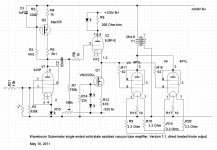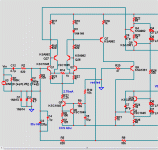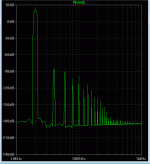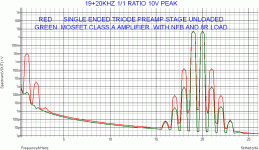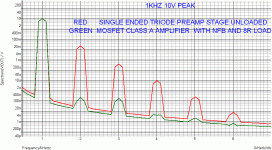Then why do so many prefer tubes, which we all know have massive THD?
Hugh
Because they want to create something that originaly is not present
in most of the recordings.
No studio recording will ever have the rich harmonic content
that occur when musicians plays together live in an environment
that allow for musical reverberations, so "tubing" the thing will
add some welcomed harmonics as would do an Aural Aphex Exciter,
that is, rendering "live" a cold studio made sound.
As a test, take a real good live album and listen to it through
a tube and a solid state amplifier.
Probability is that you will find the SS amp more punchy
while sounding as smooth with far more precision.
How about having a stab at image depth? It's difficult, if not impossible, to measure. It is a very real, albeit subjective characteristic, perhaps it can be explained in electrical terms?
what does it mean to say 'its very real'? youve said repeatedly that perhaps we're measuring the wrong things. What should we be measuring and why?
Wahab,
Given the colorations which abound in the audio world, particularly with speakers, I can't help thinking the choice of system is a matter of taste for many. Not for engineers, mind, as they want the least possible measured distortion, an ideological fixation you could say, but for many audiophiles.
I'm not looking for argument, just opining on what people want.....
Hugh
Hi Hugh,
As an exemple, in an amplifier , with a few more components
you can improve the perfs by an order of magnitude providing
we have not reached the point of rapidly vanishing returns.
With speakers, nothing of the sort, and just halving a THD
ratio mandate considerable efforts and research spendings,
with the consequence that very good quality speakers are
considerably expensive.
Of course, my amplifier is worth no more than 25% of
my speaker s value..😉
Because they want to create something that originaly is not present
in most of the recordings.
Did they tell you that?
My own contacts with audiophiles result in quite different understanding: they want as real as possible sound. I can confirm that. The closer the system sounds to the unamplified sound, the more they like it. And what I discovered recently, despite of beliefs of DIY community they don't care, if the system uses tubes, semiconductors, or horse excrement.
Agree, Wahab.
Anatoliy, I have been considering a horse excrement system in some detail. It has all the hallmarks of good sound, single ended, organic, and wonderful impact and slam... I'm working on the image depth, but it's proving difficult and smelly.
Hugh
Anatoliy, I have been considering a horse excrement system in some detail. It has all the hallmarks of good sound, single ended, organic, and wonderful impact and slam... I'm working on the image depth, but it's proving difficult and smelly.
Hugh
Did they tell you that?
My own contacts with audiophiles result in quite different understanding: they want as real as possible sound..
You just aknowledge the post you were responding to..🙂
That s it, they want a sound that sound REAL, and generaly :
No studio recording will ever have the rich harmonic content
that occur when musicians plays together live in an environment
that allow for musical reverberations,
Reverberations will provide information to positionning, i.e,
improving the sound consistencies, while acoustics intermodulations
will create the necessary sound structure that is recognized by
our ears as being "present", that is, real...
Tales from the Vienna Woods by Strauss should contain that smell, to sound realistically. According to the movie he wrote it riding horses. 😉
i have a tubeworks 300w bass amp with a switch for tube or fet for preamp stage , i hate the sound with the fets more precise but cold and lifeless , with tubes sound is warm and full.tube sound many not be more accurate than fets but are more pleasant to the ear IMO.
Last edited:
For me, natural sound is when ear's compressors make a rest instantly after the sound, because of correct wave slope detection. Care the most to the top end of loudspeaker movement to get its natural sound, that not make ears fatigued and sick.
Tube amp is distorted and not as clean as real or some other amp, the tube distortion isn't bad but good loudspeaker correction and guide will result much better.
Amplifier that make the loudspeaker sounds natural and clean is the best sounded amplifier. It is hard to achieve anyway.
Tube amp is distorted and not as clean as real or some other amp, the tube distortion isn't bad but good loudspeaker correction and guide will result much better.
Amplifier that make the loudspeaker sounds natural and clean is the best sounded amplifier. It is hard to achieve anyway.
What is for you a typical SS amp? Probability you mean a normal Class AB amplifier with typical idle current values of 20-30mA through the output buffer stage.Because they want to create something that originaly is not present
in most of the recordings.
No studio recording will ever have the rich harmonic content
that occur when musicians plays together live in an environment
that allow for musical reverberations, so "tubing" the thing will
add some welcomed harmonics as would do an Aural Aphex Exciter,
that is, rendering "live" a cold studio made sound.
As a test, take a real good live album and listen to it through
a tube and a solid state amplifier.
Probability is that you will find the SS amp more punchy
while sounding as smooth with far more precision.
Where would you file Nelson Pass "ZEN" variants and "Aleph" variants from the audible sonic character ?
Also some other single ended topologies like DOZ from westhost.com (Rod Elliott) or JLH Class-A?
More in direction to a typical solid state amp or tube amp ?
For me the amps with single ended power output contain the benefits of transistorized (solid state) amplifiers and tube amplifiers, without their individual disadvantages.
I wonder why there are so few commercial devices with this topology. A small overview you will find about
http://www.diyaudio.com/forums/soli...ended-integrated-power-amplifier-devices.html
But what about the single ended related solid state output stages, if they run in class A ?
here I am not able clearly to say, whether they to file more in direction to a typical solid state amp or tube amp. Here an overview of URL's concerning this topology:
http://www.diyaudio.com/forums/soli...e-ended-related-solid-state-output-stage.html
Last edited:
What is for you a typical SS amp? Probability you mean a normal Class AB amplifier with typical idle current values of 20-30mA through the output buffer stage.
Where would you file Nelson Pass "ZEN" variants and "Aleph" variants from the audible sonic character ?
Also some other single ended topologies like DOZ from westhost.com (Rod Elliott) or JLH Class-A?
More in direction to a typical solid state amp or tube amp ?
For me the amps with single ended power output contain the benefits of transistorized (solid state) amplifiers and tube amplifiers, without their individual disadvantages.
I wonder why there are so few commercial devices with this topology. A small overview you will find about
http://www.diyaudio.com/forums/soli...ended-integrated-power-amplifier-devices.html
But what about the single ended related solid state output stages, if they run in class A ?
here I am not able clearly to say, whether they to file more in direction to a typical solid state amp or tube amp. Here an overview of URL's concerning this topology:
http://www.diyaudio.com/forums/soli...e-ended-related-solid-state-output-stage.html
20/30mA seems low for a class AB amplifier quiescent current...
Even this might frighten some diyers, the amps you are quoting
dont seems to me to be very serious designs on the fidelity department.
There s some unsubstancied beliefs that class A and single ended topologies
are some kind of holy grail, while all evidences show that theses designs
are rarely, if ever , Hifi.
As an exemple, JLH10W and Nelson Pass Zen produce both very high
amounts of intermodulation distorsion , the worse one since it has no
relevance with the musical content.
Yet, those amps are branded as good sounding, wich is in fact
no more than a wishfull placebo like thought..
For the time, complementary designs using negative feedback
and designed to be rock stables are the best performing amplifiers,
be it in measurement or in sound quality, moreover if they use
good quality mosfets output stages, all this in an smartly
designed amplifier, as often, there s serious drawbacks due
to the designs not being engineered enough.
Because they want to create something that originaly is not present
in most of the recordings.
No studio recording will ever have the rich harmonic content
that occur when musicians plays together live in an environment
that allow for musical reverberations, so "tubing" the thing will
add some welcomed harmonics as would do an Aural Aphex Exciter,
that is, rendering "live" a cold studio made sound.
As a test, take a real good live album and listen to it through
a tube and a solid state amplifier.
Probability is that you will find the SS amp more punchy
while sounding as smooth with far more precision.
A person who does that is silly in my eyes. If you want ambience, get it through speakers with consistent radiation patterns in reasonably live rooms. Start at the speaker; the thing creating the waves that hit our ears, and work backwards from there.
Last edited:
Did they tell you that?
My own contacts with audiophiles result in quite different understanding: they want as real as possible sound. I can confirm that. The closer the system sounds to the unamplified sound, the more they like it. And what I discovered recently, despite of beliefs of DIY community they don't care, if the system uses tubes, semiconductors, or horse excrement.
+10
20/30mA seems low for a class AB amplifier quiescent current...
Even this might frighten some diyers, the amps you are quoting
dont seems to me to be very serious designs on the fidelity department.
There s some unsubstancied beliefs that class A and single ended topologies
are some kind of holy grail, while all evidences show that theses designs
are rarely, if ever , Hifi.
As an exemple, JLH10W and Nelson Pass Zen produce both very high
amounts of intermodulation distorsion , the worse one since it has no
relevance with the musical content.
Yet, those amps are branded as good sounding, wich is in fact
no more than a wishfull placebo like thought..
For the time, complementary designs using negative feedback
and designed to be rock stables are the best performing amplifiers,
be it in measurement or in sound quality, moreover if they use
good quality mosfets output stages, all this in an smartly
designed amplifier, as often, there s serious drawbacks due
to the designs not being engineered enough.
+10 Wahab .................. such is my findings 2 .....🙂
Yes , wavebourn... a tube amp with solid state current sources 😉 .
Or even close to complimentary (below 1). I never did fully realize this circuit's full potential. AKSA told me it would not "sing" on a EF2. With a better OPS (yes.. a triple running under 50mA/device) , it is golden. In retrospect , luxman was honest and cool 😎 indeed to give the public this little gem for $400 (the M120) as the $30,000 version (the B1000F) is just a refined, boosted rail version of it. No fancy TMC comp. "tricks" , this topology does not have a THD rise with frequency.
The voltage stage below ,I tried it with my genuine Hitachi to-3 laterals .... IS "the best sounding amplifier" ... to hell with the Goldmund. Bob's triple is very close (soundwise) .. BUT it has too many parts 🙁 (diamond buffer / w 2 CCS's).
Funny thing is that the FFT (below2) , is different from the classic topologies , especially unloaded.
I've built MOSFET room heaters (class A), just to have a reference but for heavy rock and movie soundtracks ... they just don't "cut it" , although the soundstage on my FLAC classical collection was reproduced very well with normal listening. But I don't do anything "normal" 😀 I want concert hall levels without needing liquid cooled heatsinks and I want to do this for a decade (MTBF). I will stick with AB class.
Short of "Equine fecal matter" , cheap silicon can be "coaxed" to be a rough facsimile of the "wire with gain". 😀
OS
For the time, complementary designs using negative feedback
and designed to be rock stables are the best performing amplifiers,
Or even close to complimentary (below 1). I never did fully realize this circuit's full potential. AKSA told me it would not "sing" on a EF2. With a better OPS (yes.. a triple running under 50mA/device) , it is golden. In retrospect , luxman was honest and cool 😎 indeed to give the public this little gem for $400 (the M120) as the $30,000 version (the B1000F) is just a refined, boosted rail version of it. No fancy TMC comp. "tricks" , this topology does not have a THD rise with frequency.
The voltage stage below ,I tried it with my genuine Hitachi to-3 laterals .... IS "the best sounding amplifier" ... to hell with the Goldmund. Bob's triple is very close (soundwise) .. BUT it has too many parts 🙁 (diamond buffer / w 2 CCS's).
Funny thing is that the FFT (below2) , is different from the classic topologies , especially unloaded.
I've built MOSFET room heaters (class A), just to have a reference but for heavy rock and movie soundtracks ... they just don't "cut it" , although the soundstage on my FLAC classical collection was reproduced very well with normal listening. But I don't do anything "normal" 😀 I want concert hall levels without needing liquid cooled heatsinks and I want to do this for a decade (MTBF). I will stick with AB class.
Short of "Equine fecal matter" , cheap silicon can be "coaxed" to be a rough facsimile of the "wire with gain". 😀
OS
Attachments
Hi Wahab;
what can you say about this single ended class A topology?
Hi Wavebourn,
Cant say that tubes amps are my cup of tea, be it SET ones...😉
Though, on the technical side of the matter, whatever the merits
of your approach , it s surely not possible to have better perfs
from cascaded stages if no feedback is applied , wich is of course
quite problematic with tube amps.
Thus, any arrangement will be stuck with very low perfs, moreover
if output transformers are used, wich is mandatory when speakers
are to be the final load..
As an axemple, here some graphs comparing a single stage triode
with an output signal of 10V peak , loaded with 10MR, so quite
less demanding that any usual load, not counting the very low amplitude.
As a comparison, a relatively good low power class A mosfet amp
with a 8R load.
You ll surely agree that a single stage SET unloaded will undoubtly
display better perfs that several devices in serial, yet, the single
stage display basic perfs that are awfull for who is in search of even
a minimal but acceptable fidelity...
Now, if this is for electric guitars amplifications , that s quite
a different matter....🙂
Attachments
Last edited:
Though, on the technical side of the matter, whatever the merits
of your approach , it s surely not possible to have better perfs
from cascaded stages if no feedback is applied , wich is of course
quite problematic with tube amps.
How would you know if you did not try this cup of tea?
Your pictures are completely irrelevant to mine.
Yes , wavebourn... a tube amp with solid state current sources 😉 .
The right way to go.
Here is a different way, without output transformer:

How would you know if you did not try this cup of tea?
Your pictures are completely irrelevant to mine.
Well, it would be nice if you could post some sims , or better,
some measurements of your two versions of your amp ,
just to allow us to have a precise idea of their capabilities..
At the risk of being contradictory, i prefer (good and percolated) coffees..😉
A first, it would be nice if you explained what kind of tube it was on your picture, and in which regime. Looks like something starving if it was a real tube, or some lousy model. In both cases. I saw recently Lineup's sim with zero THD. It's even not funny.
- Status
- Not open for further replies.
- Home
- Amplifiers
- Solid State
- Best Amplifier Sound
